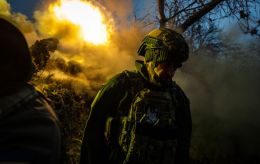Putin quietly builds new army near NATO's borders, report says
 Photo: Putin prepares for war with NATO (Getty Images)
Photo: Putin prepares for war with NATO (Getty Images)
US President Donald Trump and world leaders are increasingly concerned about Russia's ongoing war against Ukraine. Meanwhile, Russian President Vladimir Putin is expanding military bases and preparing to deploy additional troops near European borders, The Wall Street Journal reports.
Russia is expanding its military bases in Petrozavodsk and other regions near the Finnish border. Military experts see this as part of Moscow’s preparation for a potential conflict with NATO.
The bulk of new military forces will be relocated to the Leningrad military district, which borders Estonia, Latvia, and Finland, as part of plans to increase the Russian military’s personnel to 1.5 million. Small brigades will be transformed into divisions of 10,000 soldiers each.
Russia is also building new warehouses and barracks for its troops, laying new railway lines along the borders with Estonia, Finland, and Norway, as well as expanding existing rail infrastructure in the region, said Emil Kastehelmi from the Finnish OSINT analytics company Black Bird Group to the newspaper.
"When the troops return (from Ukraine - ed.), they will look across the border (with Finland - ed.) at a country they consider an enemy. The logic of the last decade shows that we expect a conflict with NATO," said a Russian military analyst, Director of the Center for Analysis of Strategies and Technologies, Ruslan Pukhov.
Military preparations
The pace of military equipment production is a sign that Russia may soon be ready for war. "The Russian army is recovering and growing at a faster pace than most analysts anticipated," said General Christopher Cavoli, commander of US forces in Europe, to a Senate committee in April. "The Russian army... today is larger than it was at the beginning of the war," the general added.
Increased military spending in Russia has led to full utilization of defense industry facilities, expansion of existing production lines, and the opening of new production sites, The Wall Street Journal reports.
According to Western intelligence estimates, while Russia produced around 40 T-90M tanks in 2021, it now manufactures about 300 of these tanks annually. Almost all of these tanks remain in Russia, rather than being sent to the front, a high-ranking Finnish military official told WSJ. The production of drones has also increased. Furthermore, production of artillery and ammunition is expected to rise by approximately 20%, WSJ notes.
Potential conflict
In February, Danish intelligence warned that Russia could start a large-scale war in Europe within five years if it believes that the North Atlantic Alliance is weak. A source from one of the European intelligence agencies told WSJ that Russia may attempt to test NATO’s cohesion by invading a small member state of the alliance, such as Estonia, which has a significant Russian-speaking population.
"If you ask how soon Russian forces could conduct a limited operation against the Baltic states, the answer might be quite soon," said Michael Kofman, Senior fellow at the Carnegie Endowment for International Peace.
Kofman stated that in the Baltic countries, it is assumed that this could happen two to three years after the war in Ukraine ends. If it comes to a large-scale war with NATO, the timeline could range from seven to 10 years, depending on the scenario, according to the expert.
As previously reported, Russia's military spending in 2024 amounted to $149 billion, which is twice as much as in 2015. This figure represents 7.1% of Russia's GDP and 19% of total state spending.

